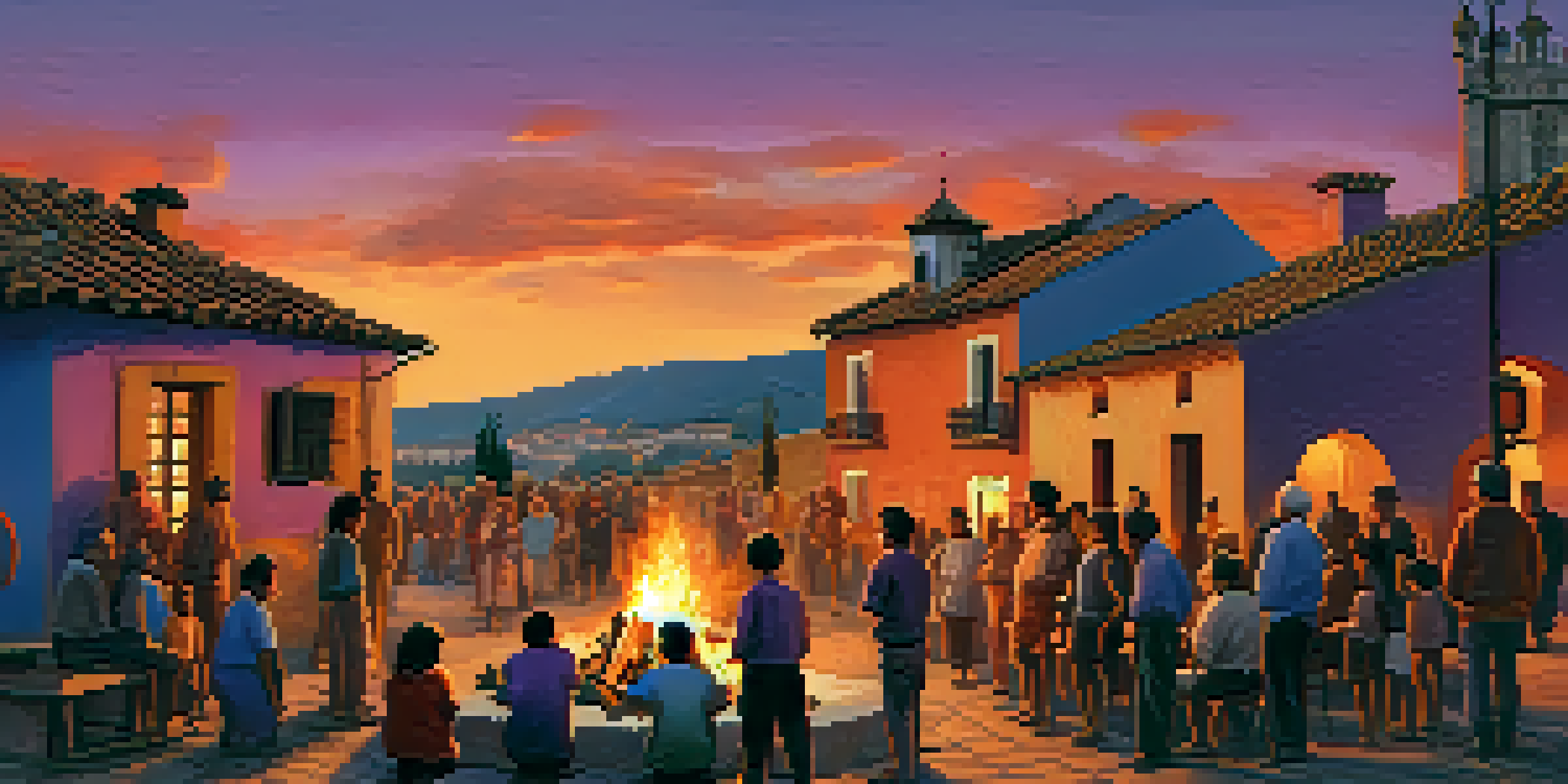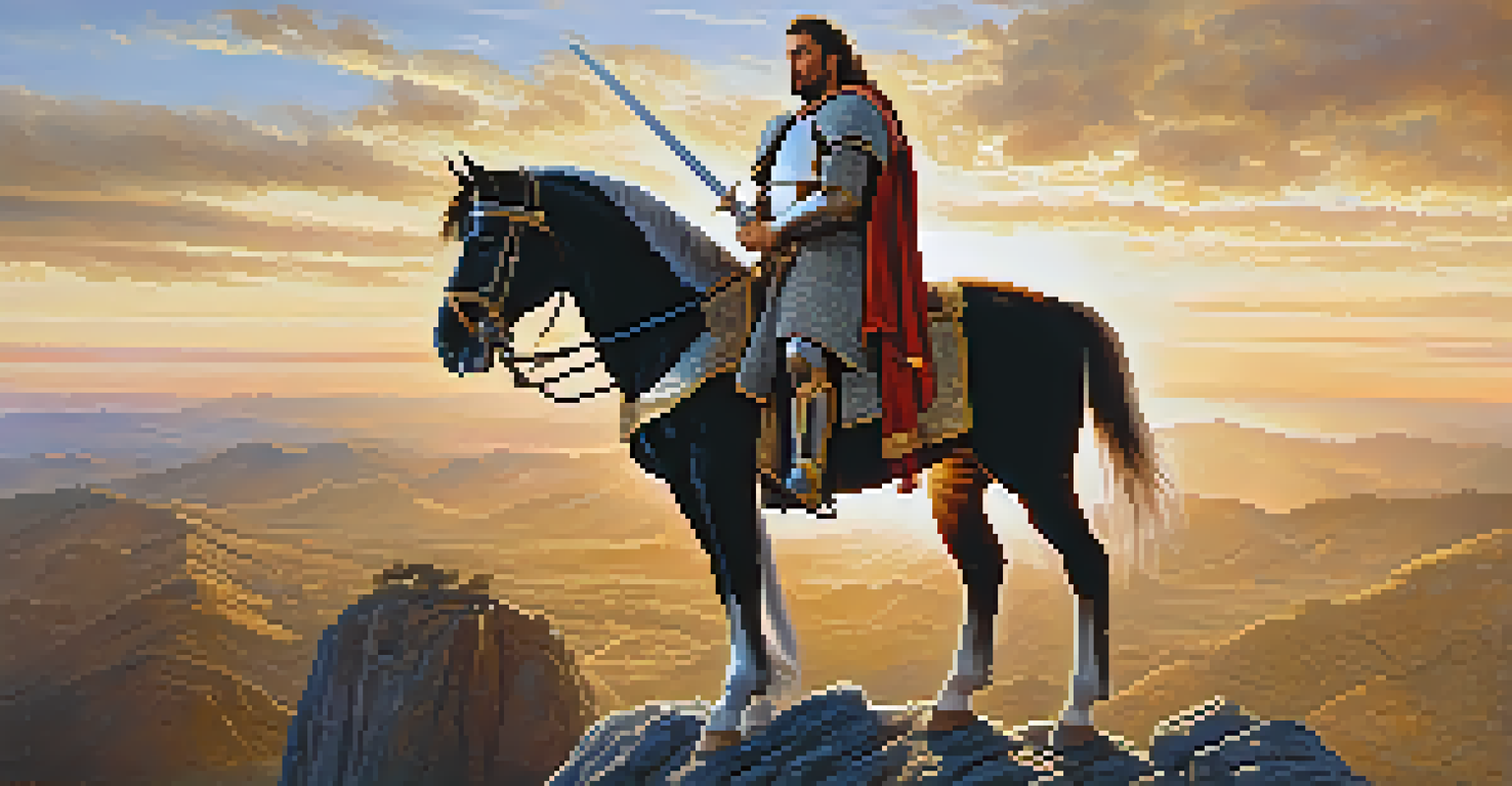Folklore Heroes: Legends in Spanish Oral Tradition

The Roots of Spanish Oral Tradition in Folklore
Spanish oral tradition is a vibrant tapestry woven with tales passed down through generations. These stories often reflect the cultural values, struggles, and aspirations of the people. As they were shared around fires or in village squares, they created a sense of community and identity.
Folklore is the heart of a people, a reflection of their culture, values, and history.
The roots of these tales can be traced back to ancient times, influenced by various cultures, including the Celts, Moors, and indigenous populations. Each group contributed unique elements to the folklore, enriching the narratives with diverse perspectives. This blend of influences is what makes Spanish folklore so captivating.
Oral tradition serves not just as entertainment but also as a means of preserving history. It allows younger generations to connect with their heritage, ensuring that the legends of heroes and mythical creatures continue to inspire and educate.
El Cid: The National Hero of Spain
One of the most iconic figures in Spanish folklore is El Cid, a nobleman and military leader from the 11th century. His story, immortalized in the epic poem 'El Cantar de mio Cid,' showcases themes of honor, loyalty, and bravery. El Cid became a symbol of the Spanish spirit, embodying the values of perseverance and courage.

El Cid's exploits against the Moors and his subsequent exile highlight the complexities of loyalty and justice. Even in the face of adversity, his resilience and tactical genius earned him respect from friends and foes alike. These qualities have cemented his status as a legendary hero.
Folklore Reflects Cultural Values
Spanish oral tradition is a vibrant tapestry that preserves cultural values, struggles, and aspirations through generations of storytelling.
The tale of El Cid continues to resonate today, inspiring countless adaptations in literature, film, and theater. His legacy serves as a reminder of the importance of standing up for one’s beliefs and fighting for what is right.
La Llorona: The Weeping Woman's Tale
La Llorona, or the Weeping Woman, is a haunting figure in Spanish-speaking cultures. Her story varies by region, but it often centers on a mother who, in a moment of despair, loses her children and is doomed to wander the rivers, crying for them. This tragic narrative serves as a cautionary tale about love, loss, and regret.
Stories are the windows to our past, helping us understand who we are and where we come from.
The tale of La Llorona reflects deep cultural values regarding motherhood and the consequences of one's actions. Parents often use her story to instill caution in their children, warning them against straying too far from home. This narrative technique not only entertains but also imparts important life lessons.
La Llorona's legend has inspired countless adaptations in literature, film, and art, showcasing her enduring impact on popular culture. Her story transcends generations, evoking both fear and empathy, reminding us of the fragility of life and love.
El Chupacabra: The Goat-Sucker of Latin America
El Chupacabra is a modern legend that emerged in the 1990s, primarily in Puerto Rico. This mysterious creature, known for allegedly attacking livestock and draining their blood, has sparked widespread intrigue and fear. Its mythos speaks to the anxieties surrounding agricultural life and the unknown.
The Chupacabra's characteristics vary widely, with descriptions ranging from a hairless dog-like creature to a reptilian being. This variability allows the legend to adapt to different contexts, demonstrating the fluid nature of folklore. As people share their experiences, the story evolves, keeping it alive and relevant.
El Cid Embodies National Spirit
The legendary figure of El Cid symbolizes Spanish honor and bravery, serving as an enduring inspiration for resilience and courage.
While some may dismiss El Chupacabra as mere superstition, its impact on culture is undeniable. It has become a symbol of fear and curiosity, inspiring a plethora of media, from documentaries to horror films, that explore the boundaries between myth and reality.
The Trickster: Coyote in Spanish Folklore
In many Spanish-speaking cultures, the trickster figure is a common archetype, often represented by the coyote. This character embodies cleverness and wit, using cunning strategies to outsmart opponents. The stories of the coyote highlight the importance of intelligence and resourcefulness in overcoming challenges.
Coyote tales often involve humorous escapades and teach valuable lessons about humility and the consequences of greed. These narratives remind us that sometimes, intelligence can triumph over brute strength. The playful nature of these stories invites laughter while imparting wisdom.
Coyote's enduring appeal in folklore reflects a universal fascination with trickster characters. They challenge societal norms and encourage us to think outside the box, making them relatable figures that resonate across cultures and generations.
The Role of Folklore Heroes in Cultural Identity
Folklore heroes play a crucial role in shaping cultural identity and pride. They embody the values and struggles of their communities, serving as symbols of resilience and hope. Through their stories, people find inspiration and a sense of belonging, connecting with their roots.
These heroes often reflect societal ideals and aspirations, acting as role models for younger generations. By celebrating their accomplishments and virtues, communities foster a sense of unity and purpose. Folklore heroes remind us of our shared history and the importance of community.
Storytelling Preserves Heritage
Storytelling is essential for preserving folklore and cultural identity, connecting the past with the present while adapting to modern contexts.
In a rapidly changing world, these stories provide a link to the past, helping individuals navigate their identities. As new generations engage with these legends, they adapt and reinterpret them, ensuring that the legacy of folklore heroes continues to thrive.
Preserving Folklore: The Importance of Storytelling
Storytelling is a powerful tool for preserving folklore and cultural heritage. By sharing these tales, communities can pass down traditions, values, and lessons learned over generations. The act of storytelling fosters connections between the past and present, ensuring that legends remain alive.
In modern times, the rise of digital media has transformed how folklore is shared. Social media platforms and podcasts offer new avenues for storytelling, allowing legends to reach wider audiences. This evolution encourages creativity, as individuals reinterpret and share folklore in contemporary contexts.

Preserving these stories is vital for maintaining cultural identity and fostering a sense of belonging. As we celebrate and share folklore heroes, we honor the rich tapestry of human experience, ensuring that the lessons and inspiration they provide endure for future generations.